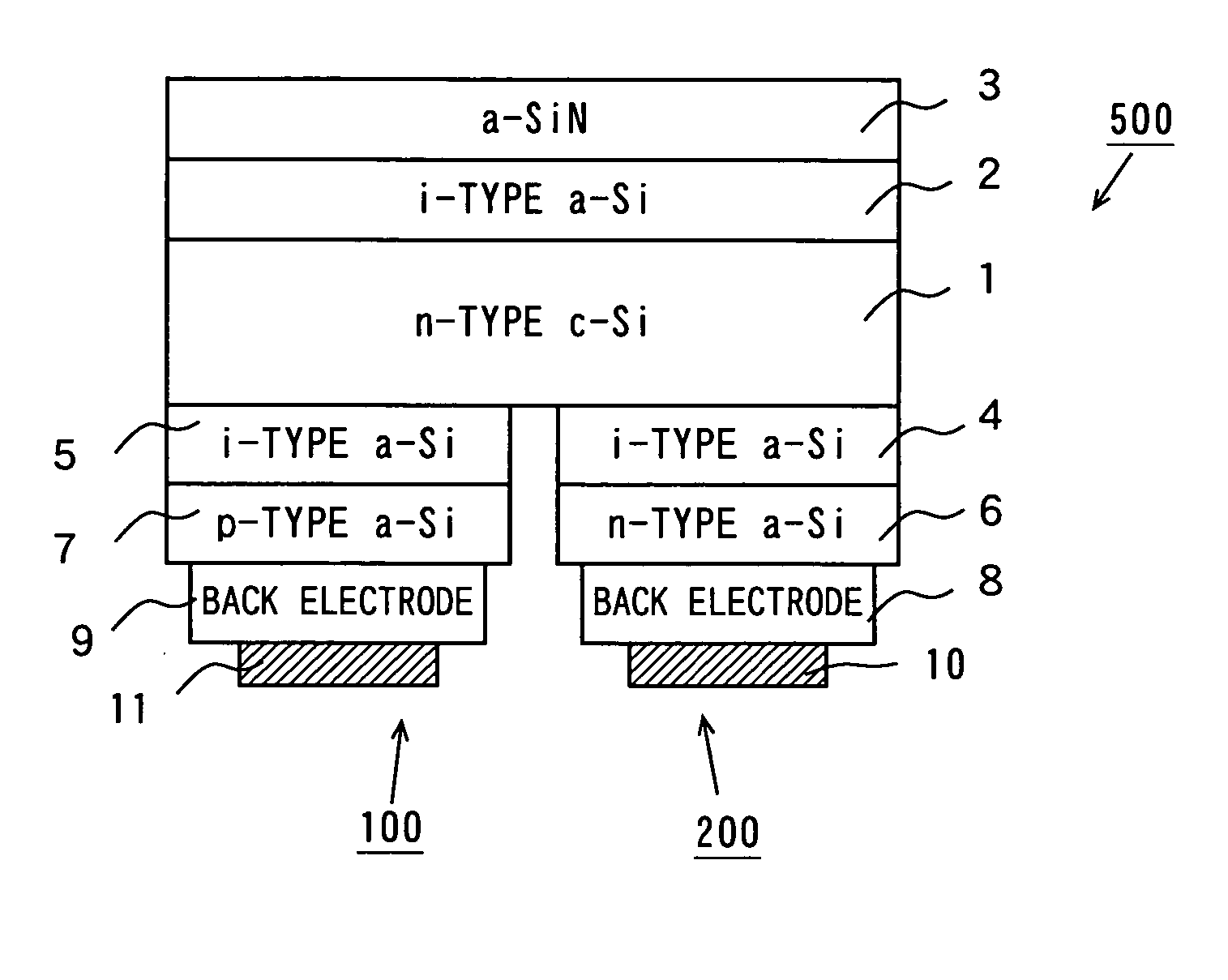Photovoltaic cell and method of fabricating the same
- Summary
- Abstract
- Description
- Claims
- Application Information
AI Technical Summary
Benefits of technology
Problems solved by technology
Method used
Image
Examples
first embodiment
[0078] A first embodiment of the present invention will hereinafter be described.
[0079]FIG. 1a is a plan view showing the back surface of a photovoltaic cell 500 according to this embodiment, and FIG. 1b is a partly enlarged view of FIG. 1a.
[0080] As shown in FIG. 1a, the photovoltaic cell 500 has a rectangular shape with its shorter side being 5 cm and longer side 10 cm, for example. The back surface of the photovoltaic cell 500 comprises positive electrodes 100 and negative electrodes 200 in a comb-shape. The positive electrodes 100 and negative electrodes 200 align alternately, each extending in the direction of the shorter side of the photovoltaic cell 500. Electrodes 300, 400 are also provided along the respective longer sides of the back surface of the photovoltaic cell 500.
[0081] As shown in FIG. 1b, the positive electrode 100 and the negative electrode 200 are provided with collector electrodes 11, 10, respectively. The collector electrode 10 is connected to the positive ...
second embodiment
[0101] A second embodiment of the present invention will hereinafter be described.
[0102]FIG. 3 is a schematic cross section showing the structure of a photovoltaic cell 500a according to the second embodiment. The photovoltaic cell 500a of FIG. 3 differs from the photovoltaic cell 500 of FIG. 1 in that it comprises impurities diffusion layer 1a in an n-type single-crystalline silicon substrate 1, instead of the i-type amorphous silicon film 4 and the n-type amorphous silicon film 6.
[0103] The impurity diffusion layer 1a is formed by thermal diffusion of P (phosphor) with high concentration on part of the region of the back surface of the n-type single-crystalline silicon substrate 1 where an i-type amorphous silicon film 5 is not formed. Then, a back electrode 8 and a collector electrode 10 are formed on the impurity diffusion layer 1a.
[0104] In this embodiment, it is not necessary to form an i-type amorphous silicon film 4 and an n-type amorphous silicon film 6 in the fabricatio...
third embodiment
[0105] A third embodiment of the present invention will hereinafter be described.
[0106]FIG. 4 is a schematic cross section showing the structure of a photovoltaic cell 500b according to the third embodiment. The photovoltaic cell 500b of FIG. 4 differs from the photovoltaic cell 500 of FIG. 1 in that an i-type amorphous silicon film 4 is in contact with an end of a p-type amorphous silicon film 7.
[0107] The method of fabricating the photovoltaic cell 500b will now be described. The method of forming an i-type amorphous silicon film 2 and an anti-reflection film 3 on the main-surface side of an n-type single-crystalline silicon substrate 1, and an i-type amorphous silicon film 5 and a p-type amorphous silicon film 7 on the back-surface side thereof is the same as that for the photovoltaic cell 500 of FIG. 2.
[0108] At the time of formation of the i-type amorphous silicon film 4 and n-type amorphous silicon film 6, a metal mask is coated so that its end face is aligned with the end ...
PUM
 Login to View More
Login to View More Abstract
Description
Claims
Application Information
 Login to View More
Login to View More - R&D
- Intellectual Property
- Life Sciences
- Materials
- Tech Scout
- Unparalleled Data Quality
- Higher Quality Content
- 60% Fewer Hallucinations
Browse by: Latest US Patents, China's latest patents, Technical Efficacy Thesaurus, Application Domain, Technology Topic, Popular Technical Reports.
© 2025 PatSnap. All rights reserved.Legal|Privacy policy|Modern Slavery Act Transparency Statement|Sitemap|About US| Contact US: help@patsnap.com



